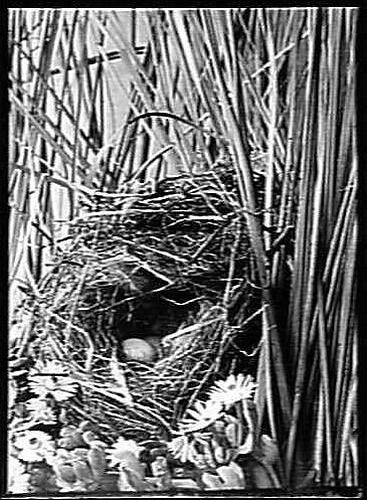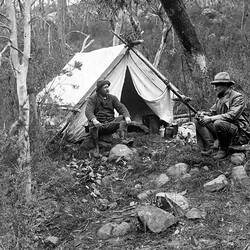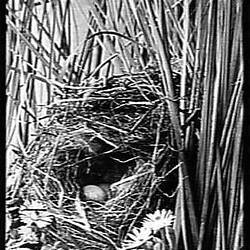STRIATED FIELD WREN (Calamanthus Fuliginosus - Vigors and Horsfield - 237)
Geographical Distribution - New South Wales, South and West (?) Australia and Tasmania.
Nest - Roundish in form, dome-shaped, with side entrance; outwardly constructed of dark, dead herbage, grass, leaves, etc., mixed with moss, then a good ply of fine, dead grass, lined inside with feathers, fur and hair. Usually placed on the ground or on the side of a bank, concealed in grass, rushes or the centre of a low bush. Dimension outwardly, 4 inches in breadth by 5 inches in length; entrance 1 ½ inches across. (See illustration.)
Eggs - Clutch, three to four; roundish in form but much pointed at one end; texture of shell fine; surface glossy; colour, vinaceous-buff with a broad belt of reddish or purplish-brown round the apex, or with an indistinct patch of that colour on the apex. Some examples are more of a purplish tone, with cloudy markings, more or less, all over the surface. Dimensions in inches of a Tasmanian clutch: (1) 0.83 x 0.64, (2) 0.82 x 0.65, (3) 0.81 x 0.62; of a pair from the mainland: (1) 0.82 x 0.6, (2) 0.82 x 0.58. (Plate 11.)
Observations - This Wren-like bird, with its pretty warble, which seems to keep time to the movement of its erect tail, claimed my attention in Tasmania, where one nest was found on the ground in the centre of a low gorse bush.
The Field Wren may be described as a striped bird, with a greenish wash on the upper surface, while the under parts have a brownish tinge. There is a distinctive white line over each eye. Length 4 ½ inches, wing 2 ½ inches, tail 2 1/8 inches, bill ½ inch, tarsus 7/8 inch.
Some Tasmanian collectors call the bird by the somewhat uneuphonious name of 'Stink Bird' or 'Stinker', because of its peculiar scent, which will cause sporting dogs sometime to 'set' the Bird.
I have noticed this same species on the mainland, notably at Mordialloc, Oakleigh and other places in Victoria. There are also undoubted examples of this bird in the National Museum, Melbourne, taken in the same colony.
Moreover, I have no doubt that the eggs procured on Coode Island, at the mouth of the Yarra, by Mr. A J. North, and described by him, are referable to this species and not to C. campestris. I procured, through my son, birds from the precise locality, and comparing them with the Tasmanian bird, can find no difference, except that the mainland bird is a trifle smaller (as a general rule, birds of a species found on the mainland are, I find, smaller than the same species from Tasmania).
Mr. A. E. Brent has found nests of the Striated Field Wren with an admixture of seaweed in their construction, and placed just above high-water mark on the Derwent, Tasmania, a favourite locality being the railway embankment close to that river.
Presuming the Field Wren found on Coode Island is C. fuliginosus, Mr. North furnishes interesting details regarding it.
The bird is one of our earliest breeders. Mr. North cites an instance when eggs were taken 24th of May. On the 17th June, 1880, he himself found four nests of this species, each containing three fresh eggs. He observes, 'The situation chosen for the nest is somewhat varied, sometimes being placed underneath a tuft of rank grass, but more often have I found it artfully concealed at the bottom of a low, stunted thick shrub growing in the wet and swampy ground at the mouth of the Yarra. The nest is rounded in form, composed of grasses and lined with feathers; the nests found at the mouth of the Yarra were all composed exteriorly of an aquatic weed. The bird at times sits very close. On one occasion, when the nest was built in the grass, the bird allowed itself to be trodden upon before leavings its eggs, which were in an advanced state of incubation.'
Breeding months, May or June (but generally August) to December or January.
Resources
Transcribed from Archibald James Campbell. Nests and Eggs of Australian Birds, including the Geographical Distribution of the Species and Popular Observations Thereon, Pawson & Brailsford, Sheffield, England, 1900, pp. 278-279
More Information
-
Keywords
-
Authors
-
Contributors
-
Article types


